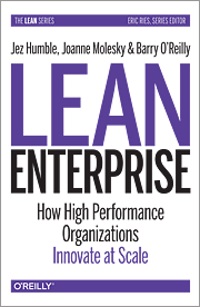By Remus Pereni, CTO Yonder
Lean Enterprise: How High-Performance Organizations Innovate at Scale
How well does your organization respond to changing market conditions, customer needs, and emerging technologies when building software-based products? The book gives you a set of tools and techniques that will help you as technology leaders to get the most value out of your technology projects and services. The book will give you case studies of successful enterprises that have rethought their governance and financial management to systems architecture and organizational culture in the pursuit of radically improved performance.
The horizons
‘The Lean Enterprise’ is founded on a highly useful concept for software product companies: the three horizons framework. This framework initially appeared in the “The Alchemy of Growth” which is an approach for mature companies to assess their potential growth opportunities without neglecting their current products.
- Horizon one – the core services and products that currently provide the greatest profits and cash flow. For these products/services, the focus should be on improving the performance to maximize the remaining value.
- Horizon two – the emerging opportunities that are currently generating revenue growth and are likely to be the ones creating tomorrow’s (1-3 years) cash flow. For these products/services, the focus should be on crossing the chasm to start contributing substantial revenue.
- Horizon three – these are the disruptive business ideas, research or pilot projects that at one point in the future (3-6 years) could become the new core product/service.
Successful companies will manage businesses all three horizons concurrently. An exemplary case study in the book is on Intuit, a business and financial software company, that has products in all three horizons. Horizon one: Turbo Tax and Mint, horizon two: QuickBooks Online Accounting, and horizon three: Snap Tax.
Lean and Agile
‘The Lean Enterprise’ presents Lean and Agile principles and patterns to help software product companies move fast at scale and demonstrates why and how to apply these methodologies throughout the organization, rather than with just one department or team. And lean is, of course, about efficiency and cutting waste. However, there is little to gain if we optimize the processes that are not the actual bottlenecks. By using techniques from the lean world such as value stream mapping, we get a way to understand where the problems start. Through value stream mapping we visualize what the value-creating processes are. And we calculate metrics such as:
- lead time – the time from the acceptance of a process (piece of work) to handing it off to the next downstream process,
- process time – time required to complete a single item of work,
- percentage complete and accurate – a proportion of the complete and correct items that represents how much work is wasted due to rework.
We then have a clear image of how we build things or deliver services, and by calculating simple matrices as the ones above, the real bottlenecks become visible and allow us to work on improving those things that actually matter and have an impact.
To reduce wasted opportunities and resources, the authors introduce the Cost of Delay method which makes sure that we are working on the right things. Cost of Delay provides a way to measure the value of time by calculating a score from the cost of delay (amount of money we lose by not having the feature now) divided by the duration to build the feature. The teams can now make clear decisions and create priorities by quantifying the value of the work, thus avoiding low-value work and focusing on performing the high-value tasks first.
Mission command decision making
Organizations need to get comfortable operating in a world of uncertainty and imperfect information. One way to facilitate innovation is by shifting the decision-making process to ‘mission command’ as opposed to ‘command and control.’ Traditional ‘command and control’ management does not adapt very well to the real world where friction prevents reality to behave in an ideal way. Approaches and methods like mission-command, double feedback loops, improvement kata and Hoshin Kanri (also called Policy Deployment) create organizational cultures driven by continuous improvements that thrive in a changing and imperfect world like ours.
A very interesting book, providing us the tools to survive and be extremely successful in our volatile world. The authors use case studies to illustrate their findings. They provide insights into how to lead and manage large-scale programs in a way that empowers employees, increases the speed and quality of delivery, and lowers costs. The reader learns how to implement ideas from the DevOps and Lean Startup movements even in complex, regulated environments.
Has the book sparked an interest? Do you want to discuss it and find out how the principles could apply to your software product company? Then get in touch with us and we will come by, discuss it over a cup of coffee, and leave you a copy of the book. If you are located abroad, we will set up a skype call and send you the book afterwards.
Note: Jez Humble, one of the four authors of the book, is also one of the founders of the DevOps and Continuous Delivery movement. It will be essential for our next generation of technology leaders to have exposure to and understanding of these concepts.
ISBN10 1449368425
STAY TUNED
Subscribe to our newsletter today and get regular updates on customer cases, blog posts, best practices and events.











